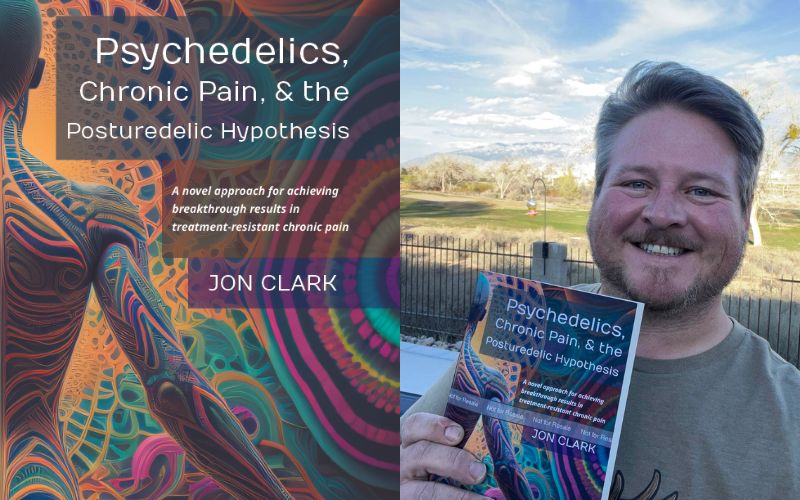The psychedelic renaissance has mostly focused on the potential for psilocybin, MDMA, ibogaine and other compounds to treat mental-health conditions and substance-use disorders.
But Jon Clark’s forthcoming book, “Psychedelics, Chronic Pain & the Posturedelic Hypothesis,” begs the question: “What if psychedelics aren’t just for mental health?”
The book, set for release on June 4, chronicles Clark’s struggle with treatment-resistant chronic pain and suicidal depression, and how he discovered the power of psychedelic-assisted posture therapy – which Clark calls “posturedelic” therapy.
When he was 17, Clark broke his L5 vertebra in a skiing accident. In the book, he describes the next 16 years as “a downward spiral of ever-decreasing mobility and ever-increasing chronic pain” that eventually confined him to a wheelchair for three years.
As Clark sought relief for his muscle spasms, soft-tissue pain, nerve pain and carpal tunnel, doctors branded him with a litany of diagnoses, including fibromyalgia, chronic fatigue syndrome, complex regional pain syndrome and conversion disorder.
However, traditional Western treatment modalities – as well as alternative and Eastern approaches – failed to provide relief, while draining his financial resources and his spirit.
By January 2019, Clark had hit rock-bottom. He had ballooned to 425 pounds, suffered from “horrible, constant pain” and relied on alcohol and marijuana “just to get a few hours of sleep at a time.”
Looking back on this dark time in his life, he remembers each day as “a monotonous exercise in not swallowing a bullet.”
At this time, his dad bought him a book about posture therapy. Reading the book – “Pain Free: A Revolutionary Method for Stopping Chronic Pain” by Pete Egoscue – turned out to be the first step in his road to recovery.
“It was a form of exercise I could actually do without hurting myself,” Clark recalls in his book. “I began doing it every day, and two months later, I stood up from my wheelchair for a few seconds. My dad hired a therapist, and I enrolled in an online curriculum to become a posture therapist myself, as I knew I needed to master this technique if I wanted to live a different life.”
Nine months after reading the book on posture therapy, Clark was able to move without a wheelchair. But then, he says, his progress plateaued.
And the pain persisted for years.
Clark’s turning point was “an impromptu and desperate experiment with psilocybin and posture therapy.”
“During a particularly profound psychedelic experience where I combined several hours of posture therapy with a couple of grams of mushrooms, I gained the tools I needed to begin making extraordinary progress,” Clark explains in the book. “Six months later, I competed in my first disc-golf tournament, which was a nine-mile hike through the mountains outside Albuquerque, New Mexico. While I came in absolute last place, I couldn’t have been happier with my progress!”
Prior to the disc-golf tournament, Clark received his Postural Alignment Specialist certification from the Egoscue Institute and launched a new career.
“I have since lost count of how many people I’ve helped empower to reduce or even eliminate their own chronic pain problems using standard posture therapy,” Clark says. “However, I also found that in some cases, such as mine, the necessary duration of treatment allowed pain to wreak havoc on these people’s lives even while they progressed steadily.”
After watching a client lose her battle with chronic pain, Clark became obsessed with learning why adding psychedelics to the mix had helped him so much – and how to safely replicate his results for other people. That inspired him to develop posturedelic therapy, which he describes as a “novel protocol for integrating the psychedelic experience with posture therapy.”
“While I certainly don’t claim to understand what exactly is going on in the brain to produce the psychedelic experience – I don’t think anyone truly knows, to be honest – in the course of that quest, I came to believe it is possible to coax this altered state of consciousness into targeting the kind of breakthrough results I experienced in a more systematized, repeatable fashion,” Clark says.
The first half of the book takes a deep dive into the fundamental processes undergirding posture therapy, with chapters devoted to posture analysis, functional testing, posture categorization and routine design.
The second half of the book delves into the foundations of “the posturedelic hypothesis,” taking readers on “a profound exploration of the intricate relationship between our minds and bodies.” This section of the book includes a detailed, step-by-step breakdown of the posturedelic-therapy process, discussing key considerations such as set and setting, contraindications and drug interactions, sourcing safe psychedelics, session flow and proper dosage.
Clark, however, “strongly advise[s] against performing a posturedelic journey without professional facilitation,” asserting that he provides the information on practical application “to offer academic transparency as to the nature of the technique I am proposing.”
“I did my first posturedelic sessions completely unsupervised and it saved my life, so I felt hypocritical putting out a book advising people to do as I say, not as I did,” Clark adds.
“Psychedelics, Chronic Pain, & the Posturedelic Hypothesis” is scheduled for a June 4 release on all Amazon markets in e-book and print format, with a wider international release to follow.
You can learn more about Clark’s story via his “Chronic Pain Rewired” podcast.

